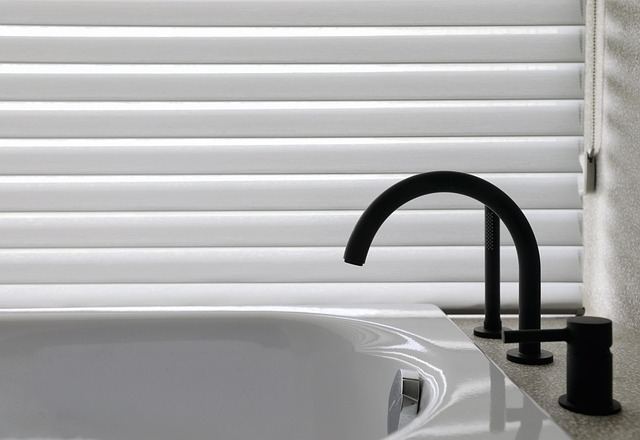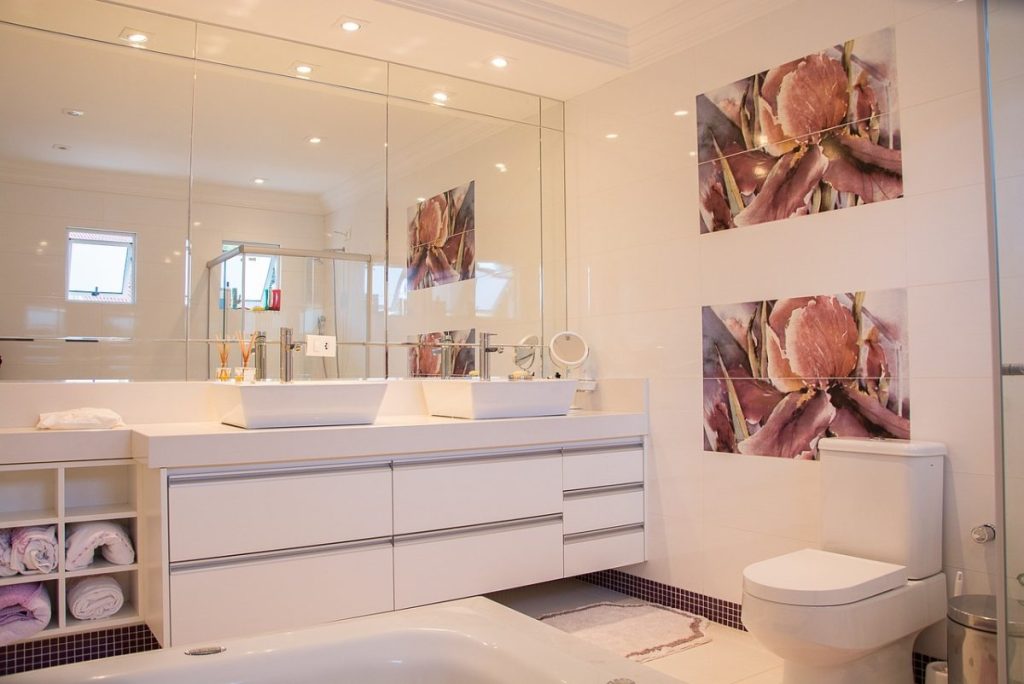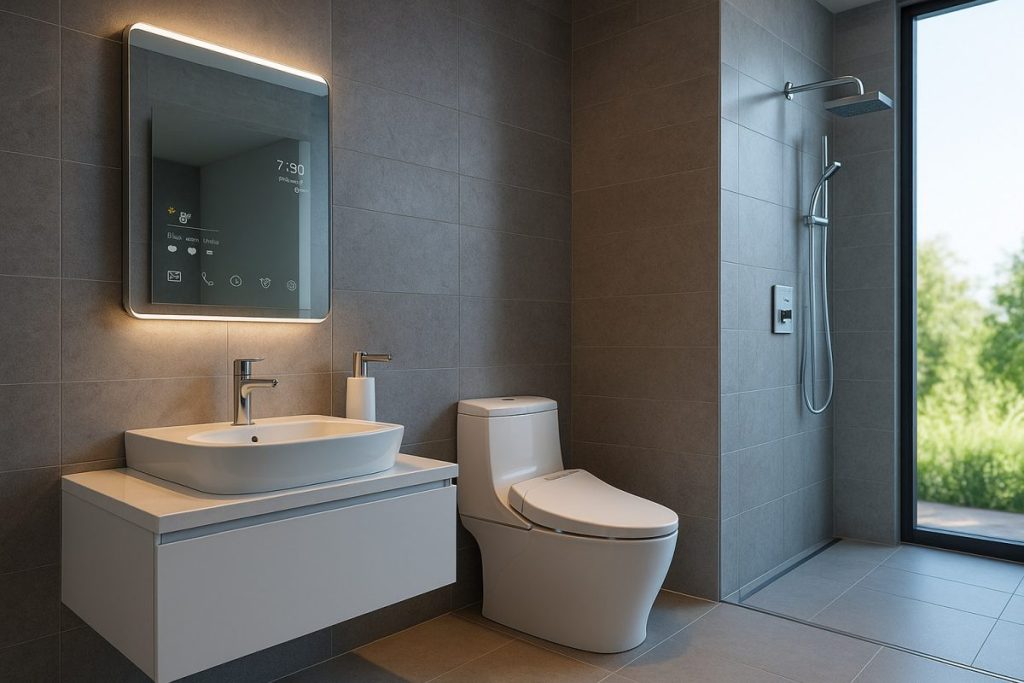In 2025, the bathroom is no longer just a functional space—it’s a hub of innovation. With the rise of smart home technology, bathrooms are getting a high-tech makeover. From automatic faucets to AI-powered mirrors, the smart bathroom combines hygiene and automation to create a cleaner, more convenient daily experience. Let’s explore what this transformation means, what devices are trending, and how you can upgrade your bathroom for the future.
What is a Smart Bathroom?
A smart bathroom integrates connected devices and automation to enhance hygiene, comfort, and water efficiency. Think of it as the bathroom version of a smart home—intuitive, hands-free, and customized to your routine.
Common Smart Bathroom Features:
- Touchless faucets and soap dispensers
- Smart toilets with bidet functions
- Voice-controlled lighting and music
- App-connected showers for personalized temperature
- Fogless smart mirrors with built-in lighting and health tracking
These innovations offer more than just convenience—they support better hygiene and resource management, two critical concerns in modern households.
Why Hygiene and Automation Matter
The COVID-19 pandemic shifted global awareness toward cleanliness. Touchless technology became mainstream, and the bathroom was a prime candidate for an upgrade. Smart bathrooms reduce contact points, automate cleaning functions, and help prevent the spread of germs.
Hygiene Benefits:
- Reduced contamination through motion-sensing devices
- Self-cleaning toilet bowls and UV sanitization
- Filtered water for washing hands or brushing teeth
- Hands-free flushing systems for improved public and private hygiene
These features aren’t just about luxury—they’re about health and sustainability.
Top Smart Bathroom Devices in 2025
Here are some of the most sought-after products powering modern bathrooms:
1. Smart Toilets
Brands like Toto and Kohler lead the market with features like heated seats, bidet sprays, auto-flush, and odor control.
2. Smart Showers
Control water temperature and duration through apps or voice assistants. Save presets for each family member.
3. Smart Mirrors
Display weather, news, time, and health data while you brush your teeth. Some mirrors even monitor your skin condition or hydration levels.
4. Automatic Soap Dispensers
A small upgrade with a big impact—no need to touch a pump when washing hands.

5. Smart Lighting Systems
Motion-activated or voice-controlled lights reduce energy waste and increase convenience during nighttime use.
Energy and Water Efficiency
Smart bathrooms are not only convenient—they’re eco-friendly. Most smart devices help conserve resources through automation and monitoring.
- Water-saving smart showers regulate flow without compromising pressure.
- Leak detection sensors help prevent water damage and reduce waste.
- Smart toilets use minimal water per flush depending on need.
How to Build Your Smart Bathroom
You don’t have to remodel your entire space to get started. Begin with these entry-level upgrades:
| Budget-Friendly Upgrades | High-End Transformations |
|---|---|
| Motion-sensor lights | Full smart toilet systems |
| Smart plug for hair tools | Touch-screen mirror installation |
| Automatic soap dispenser | App-controlled shower systems |
Over time, you can integrate your devices using voice assistants like Alexa or Google Assistant for centralized control.
Privacy and Security Considerations
As with any smart system, privacy is a factor. Devices that use cameras or microphones (like smart mirrors or assistants) should come from reputable brands with clear data policies. Always secure your home Wi-Fi and keep firmware updated.
Smart Bathrooms: Not Just for Homes
Hotels, office buildings, and high-end public restrooms are adopting smart bathroom technologies too. This means visitors can enjoy hygiene-focused design even outside their homes—driving broader adoption of this growing trend.

Final Thought
Smart bathrooms represent the next frontier in personal hygiene, sustainability, and lifestyle design. By combining automation with cleanliness, they’re changing how we interact with one of the most-used rooms in the house. Whether you’re building a futuristic home or just want fewer germs on your hands, a smart bathroom is a smart move.
FAQ: Smart Bathrooms
Q: What makes a bathroom “smart”?
A: A smart bathroom uses connected devices to automate tasks, improve hygiene, and enhance comfort—such as motion-sensing faucets, smart mirrors, and app-controlled showers.
Q: Are smart bathroom devices expensive?
A: Prices vary. Some devices like automatic soap dispensers are affordable, while smart toilets and mirrors can cost more. You can start small and upgrade over time.
Q: Can I install smart bathroom tech myself?
A: Many devices are plug-and-play and DIY-friendly. Others, like smart showers or toilets, may require professional installation.
Q: Are smart bathrooms safe from hacking?
A: Yes, if you follow best practices—use secure Wi-Fi, buy reputable brands, and keep device software updated.
Q: Do smart bathrooms save water?
A: Yes. Smart toilets and showers are designed to optimize water usage, often reducing waste compared to traditional systems.
- Designing a Smarter Home in 2026: What People Get Wrong About AutomationSmart homes were once science fiction, but today they’re a reality in millions of households. With voice assistants, smart plugs, and automated lighting systems, it’s easy to assume home automation is simply a matter of plugging in a few devices. Yet, many homeowners quickly discover that “smart” doesn’t always mean simple. In this article, we’ll…
- Automated Online Trading: How IoT is Redefining Financial MarketsIntroduction automated online trading In a world where milliseconds can decide millions, the fusion of Internet of Things (IoT) technology and automated online trading is reshaping global finance. What once relied solely on human judgment now increasingly depends on connected machines, real-time data, and predictive algorithms. From weather sensors influencing agricultural trades to smart logistics…
- The Role of Linux in IoT: Powering the Connected WorldThe Internet of Things (IoT) is everywhere—from smart homes and wearable devices to industrial automation and self-driving cars. Behind the scenes, one operating system plays a surprisingly dominant role: Linux. Known for its stability, flexibility, and open-source nature, Linux has become the backbone of countless IoT devices and platforms. But what makes Linux so well-suited…
- The Smart Home Revolution in 2025: How IoT is Transforming Everyday LivingIn the past decade, the vision of a truly smart home has moved from futuristic fantasy to everyday reality. As we step into 2025, the Internet of Things (IoT) has matured into a robust ecosystem, connecting appliances, security systems, lighting, and even entertainment devices under one seamless digital roof. The result? Homes that are safer,…
- IoT and Data Privacy: How Safe Is Your Smart Home in 2025? – IoT SecurityThe smart home revolution has made everyday life more convenient than ever. From voice assistants that control the lights to security cameras that send alerts directly to your phone, connected devices have become part of our daily routines. But with this convenience comes an important question: how safe is your personal data in a world…








